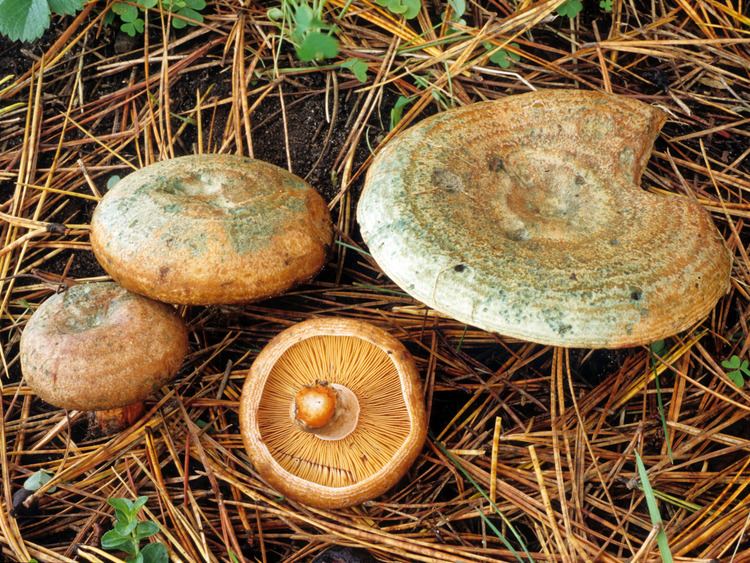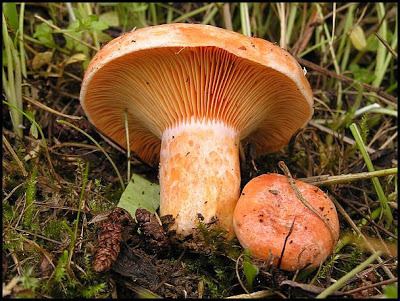Kingdom Fungi | Division Basidiomycota Scientific name Lactarius deliciosus Rank Species | |
 | ||
Similar | ||
Good bad and ugly fungi of australia saffron milkcap lactarius deliciosus
Lactarius deliciosus, commonly known as the saffron milk cap and red pine mushroom, is one of the best known members of the large milk-cap genus Lactarius in the order Russulales. It is found in Europe and has been accidentally introduced to other countries under conifers and can be found growing in pine plantations. A fresco in the Roman town of Herculaneum appears to depict Lactarius deliciosus and is one of the earliest pieces of art to illustrate a fungus.
Contents
- Good bad and ugly fungi of australia saffron milkcap lactarius deliciosus
- Lactarius deliciosus fungi kingdom
- Taxonomy
- Description
- Distribution and habitat
- Edibility
- Chemistry
- References

Lactarius deliciosus fungi kingdom
Taxonomy

This was known to Linnaeus who officially described it in Volume Two of his Species Plantarum in 1753, giving it the name Agaricus deliciosus, the specific epithet deriving from Latin deliciosus meaning "tasty". The Swedish taxonomist allegedly gave the species its epithet after smelling it and presuming it tasted as good as a Mediterranean milk cap highly regarded for its flavor. Dutch mycologist Christian Hendrik Persoon added the varietal epithet lactifluus in 1801, before English mycologist Samuel Frederick Gray placed it in its current genus Lactarius in 1821 in his The Natural Arrangement of British Plants.

It is commonly known as saffron milk-cap, red pine mushroom, or simply pine mushroom in English. An alternate North American name is orange latex milky. Its Spanish name varies (níscalo, nícalo, robellón...). Its Catalan name is rovelló (pl. rovellons). In the Girona area, it is called a pinatell (in Catalan) because it is collected near wild pine trees; it is typically harvested in October following the late August rains. Both this and Lactarius deterrimus are known as Çam melkisi or Çintar in Turkey. In Romania, it is known as Rascovi and it can be found in the northern regions in autumn season.
Description
Lactarius deliciosus has a carrot orange cap which is convex to vase shaped, inrolled when young, 4 to 14 cm (1.5 to 5.5 in) across, often with darker orange lines in the form of concentric circles. The cap is sticky and viscid when wet, but is often dry. It has crowded decurrent gills and a squat orange stipe which is often hollow, 3 to 8 cm (1 to 3 in) long and 1 to 2 cm (0.5 to 1 in) thick. This mushroom stains a deep green color when handled. When fresh, the mushroom exudes an orange-red latex or "milk" that does not change color.

In North America, this mushroom is often confused with Lactarius rubrilacteus which stains blue, exudes a red latex, and is also edible.
Distribution and habitat

Lactarius deliciosus grows under conifers on acidic soils and forms a mycorrhizal relationship with its host tree. It is native to the southern Pyrenees where it grows under Mediterranean pines, as well as throughout the Mediterranean basin, in Bulgaria, Spain, Greece, Italy, Cyprus, France and elsewhere. Both this fungus and L. deterrimus are collected and sold in the İzmir Province of southwestern Turkey, and the Antalya Province of the south coast. In the island of Cyprus, huge numbers of Lactarius deliciosus are found in the high altitude Pinus nigra and Pinus brutia forests, where locals hunt them with vigour, as this fungus is highly esteemed among the local delicacies.
After analysing DNA from collections around the world, mycologists Jorinde Nuytinck, Annemieke Verbeken, and Steve Miller have concluded that L. deliciosus is a distinct European species that differs genetically, morphologically, and ecologically from populations in North America or Central America. It has been reportedly introduced to Chile, Australia and New Zealand, where it grows in Pinus radiata plantations. Popular places for collecting this mushroom, especially among the Polish community, are around Macedon in Victoria, and in the Oberon area in New South Wales, Australia, where they can grow to the size of a dinner plate. Many people of Italian, Polish, Ukrainian and other eastern European ancestry in the states of Victoria and New South Wales, Australia travel to collect these mushrooms after autumn rainfall around Easter time.
Lactarius deliciosus is also very popular in Russian cuisine, and Siberian pine forests are a favourable habitat of this species. The mushrooms are being collected in August to early October, where they are traditionally fried, salted or pickled.
Edibility
Lactarius deliciosus is a widely collected mushroom in the Iberian peninsula, specially in the northern part of Catalonia. It is used in Spanish and Catalan cuisine. One recipe recommends they should be lightly washed, fried whole cap down in olive oil with a small amount of garlic and served drenched in raw olive oil and parsley. The same recipe advised that butter should never be used when cooking this mushroom.
Further north and east it is a feature of Provençal cuisine.
They are also collected in Poland, where they are traditionally served fried in butter, with cream, or marinated.
In Russian cuisine these mushrooms are prepared with pickling and then eaten with sour cream.
In India, the fungus is one of the ten most widely consumed mushrooms by ethnic tribes of Meghalaya. In Cyprus, where they are usually cooked on charcoal and marinated with olive oil and lemon or bitter orange, or fried with onions with red wine.
In some older guides, the saffron milk cap is considered an excellent mushroom, having 'a crisp texture'. In fact, when naming the mushroom, the mycologist had mistaken the mushroom with Lactarius sanguifluus, which is an excellent, pleasantly crunchy mushroom. Today, most mycologists hold Lactarius sanguifluus in higher esteem than its pretender, Lactarius deliciosus.
High consumption of Lactarius deliciosus could cause urine discoloration, namely coloring it orange/red
Chemistry
When grown in liquid culture, the mycelium of Lactarius deliciosus produces a mixture of fatty acids and various compounds such as chroman-4-one, anofinic acid, 3-hydroxyacetylindole, ergosterol, and cyclic dipeptides.
